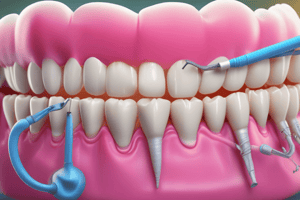Podcast
Questions and Answers
What is one of the patient-related factors for fluid control?
What is one of the patient-related factors for fluid control?
- Increased accessibility to operative site
- Protects patient soft tissues – tongue, cheeks by retracting them from operating field (correct)
- Infection control to minimize infection
- Less fogging of the dental mirror
How does fluid control help in operator-related factors?
How does fluid control help in operator-related factors?
- Improves the working field and diagnosis
- Minimizes infection
- Decreases vision of cavities during preparation
- Prevents contamination of cavity preparation/root canal (correct)
What is a technique-related factor for fluid control?
What is a technique-related factor for fluid control?
- A small round bur detached and lodged in patient's left bronchus
- Protects patients from swallowing or aspirating foreign bodies
- Moisture interfering with the setting reaction of materials (correct)
- Wasting time
What is an example of a restorative material and technique related factor?
What is an example of a restorative material and technique related factor?
What is a significant consequence of not using fluid control in restorative procedures?
What is a significant consequence of not using fluid control in restorative procedures?
How does fluid control contribute to visibility in operative procedures?
How does fluid control contribute to visibility in operative procedures?
What is the primary purpose of using cotton rolls in moisture control during dental procedures?
What is the primary purpose of using cotton rolls in moisture control during dental procedures?
Which of the following is a potential disadvantage of using cotton rolls for moisture control?
Which of the following is a potential disadvantage of using cotton rolls for moisture control?
In what way does moisture contamination affect amalgam restorations?
In what way does moisture contamination affect amalgam restorations?
What is the primary function of an air water syringe in moisture control during dental procedures?
What is the primary function of an air water syringe in moisture control during dental procedures?
How does moisture contamination affect anterior esthetic restorations?
How does moisture contamination affect anterior esthetic restorations?
What is a potential effect of moisture contamination on gold foil restorations?
What is a potential effect of moisture contamination on gold foil restorations?
What is one potential advantage of using a rubber dam for moisture control during dental procedures?
What is one potential advantage of using a rubber dam for moisture control during dental procedures?
What is the primary function of a saliva ejector in moisture control during dental procedures?
What is the primary function of a saliva ejector in moisture control during dental procedures?
What is a potential disadvantage of using cotton roll holders for moisture control during dental procedures?
What is a potential disadvantage of using cotton roll holders for moisture control during dental procedures?
What method of moisture control relies on attraction of cohesive property as increments are cleaned from oxides?
What method of moisture control relies on attraction of cohesive property as increments are cleaned from oxides?
What is a potential disadvantage of using absorbents for moisture control during dental procedures?
What is a potential disadvantage of using absorbents for moisture control during dental procedures?
What is the position of the saliva ejector tip during placement?
What is the position of the saliva ejector tip during placement?
What material are high volume evacuating (HVE) tips made of?
What material are high volume evacuating (HVE) tips made of?
What is the primary function of a saliva ejector?
What is the primary function of a saliva ejector?
What is the primary advantage of using a Fast Dam during dental procedures?
What is the primary advantage of using a Fast Dam during dental procedures?
What is a potential caution associated with high volume evacuating equipment (HVE)?
What is a potential caution associated with high volume evacuating equipment (HVE)?
What is the preferred equipment for suctioning water and debris from the mouth?
What is the preferred equipment for suctioning water and debris from the mouth?
What is the primary advantage of using reflective shields for moisture control during dental procedures?
What is the primary advantage of using reflective shields for moisture control during dental procedures?
Which type of absorbent pads is most commonly used inside the cheeks to cover the parotid ducts?
Which type of absorbent pads is most commonly used inside the cheeks to cover the parotid ducts?
What is the characteristic of Silver Absorbent Wafers that distinguishes them from other absorbent pads?
What is the characteristic of Silver Absorbent Wafers that distinguishes them from other absorbent pads?
What is the primary function of a saliva ejector in moisture control during dental procedures?
What is the primary function of a saliva ejector in moisture control during dental procedures?
What is the purpose of using Dry Angles for moisture control during dental procedures?
What is the purpose of using Dry Angles for moisture control during dental procedures?
What is the distinguishing feature of Reflective shields that aids in moisture control during dental procedures?
What is the distinguishing feature of Reflective shields that aids in moisture control during dental procedures?
Flashcards are hidden until you start studying




